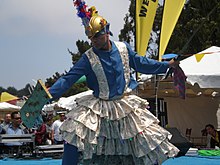Sagayan

Sagayan is a Philippine war dance performed by Maguindanao, Maranao and Iranun depicting in dramatic fashion the steps their hero, Prince Bantugan, took upon wearing his armaments, the war he fought in and his subsequent victory afterwards.[1] Performers, depicting fierce warriors would carry shields with shell noisemakers in one hand and a kampilan sword in the other attempting rolling movements to defend their master.[2]
Dancers of the Sagayan wear costumes based on descriptions of Bantugan's equipment in the epic Darangen. He was described as wearing the kapasti (a headress with embedded mirrors), clothes with the colors of the rainbow, klong (shield) made of the hardest wood and with small bells, a blindingly shiny kampilan (a large double-tipped war sword) tied to the wrist with five or seven holes decorated with animal hair, and a magerag (a shorter secondary sword). Among the Maguindanao people, the kapasti is usually interpreted as a sayap (a traditional conical headdress), brightly colored and decorated with feathers, mirrors, and tassels. The clothing is interpreted as a three-tiered skirt of red, green, and yellow.[3]
The name "sagayan" is a loanword and comes from the Tausug word sagay, meaning "headhunter."[3]
See also[edit]
References[edit]
- ^ Mercurio, Philip Dominguez (2007). "Traditional Music of the Southern Philippines". PnoyAndTheCity: A center for Kulintang - A home for Pasikings. Retrieved 15 February 2007.
- ^ Cruz, Gray (2006). "Galleries, Repertoire, Mindanao". Likha Pilipino Folk Ensemble. Likha Pilipino Folk Ensemble. Retrieved 15 February 2007.
- ^ a b Maruhom, Sahria (21 October 2013). "Sagayan: The Dance of Meranao Royalty". JPAIR Multidisciplinary Research. 14 (1): 104–115. doi:10.7719/jpair.v14i1.238.
